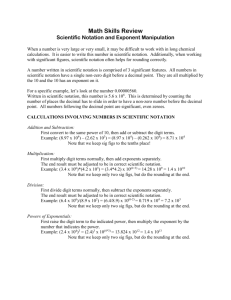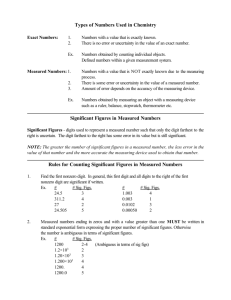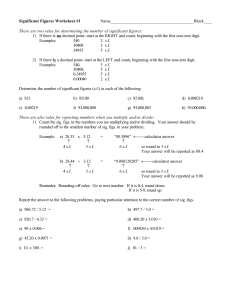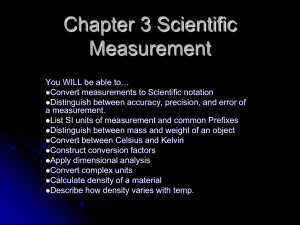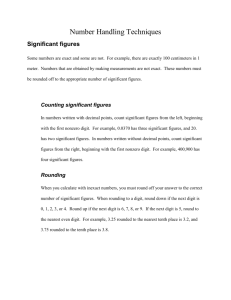CHAPTER 2
advertisement
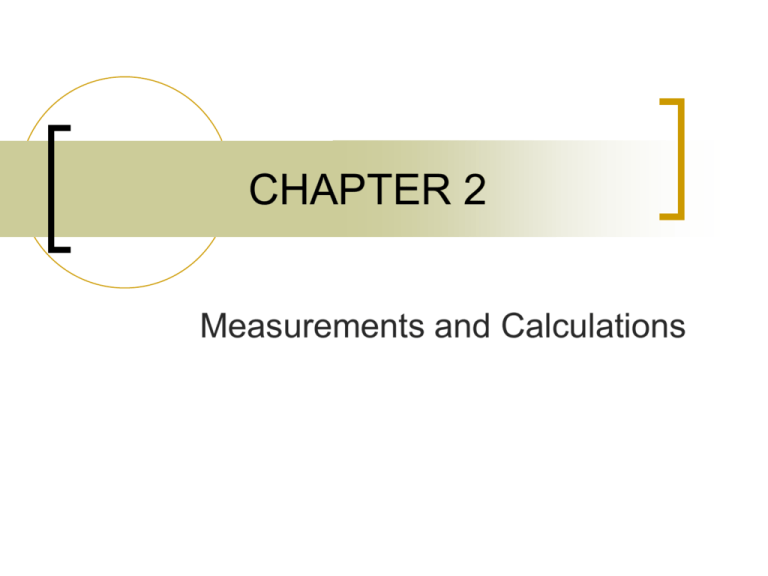
CHAPTER 2 Measurements and Calculations Scientific Method System Specific portion of matter that has been selected for study Scientific Method Logical approach to solve a problem Scientific Method Steps Observing and collecting data Use of senses Quantitative data – numerical Qualitative data - descriptive Generalization – statements about what is observed Organizing – Graphs, tables, statistics Hypothesis – testable statement Law – statement that DESCRIBES facts Scientific Method Steps Theorizing Statement that EXPLAINS facts Can never be proven!! Testing Experimentation Units of Measurement Unit of Measurement A physical quantity of a defined size lb, in, ft, g, cm, km SI International System of Units (metric system) Adopted in 1960, originated in France SI SI base units – standard of measure – Have a defined size Length – meter (m) Mass – kilogram (kg) Time – second (s) Temperature – Kelvin (K) SI Prefixes Prefix Symbol Example Exponential Factor Factor Tera T Terameter 1012 1000000000000 Giga G Gigameter 109 1000000000 Mega M Megameter 106 1000000 Kilo K or k Kilometer 103 1000 Hecto H Hectometer 102 100 Deca D Decameter 101 10 ---- ---- meter 100 ---- Deci d Decimeter 10-1 0.1 Centi c Centimeter 10-2 0.01 Milli m Millimeter 10-3 0.001 Micro µ Micrometer 10-6 0.000001 Nano n Nanometer 10-9 0.000000001 Pico p Picometer 10-12 0.000000000001 Know the ones in BOLD above!!! SI Prefixes Number Line – MEMORIZE!! KHD With meters: Examples: dcm__µ Derived SI Units Derived Unit – obtained from combining base units Area Volume L*w*h m3 Speed L*w m2 Length/time m/s Density Mass/volume g/mL or g/cm3 Conversion Factors and Factor-Label Method Factor-Label Method – problem solving method using algebra Conversion Factors = 1 Examples: Using Scientific Measurements Accuracy Precision Closeness of a measurement to the true or accepted value Agreement among the values Percent Error Experimental value – Accepted Value x 100% Accepted Value http://honolulu.hawaii.edu/distance/sci122/SciLab/L5/accprec.html Measuring Always estimate one more place than the measuring device Significant Figures Sig Figs – gives the amount of detail in a measurement How many sig figs in a number? Table 2-5 page 47 Sig Figs Rules All non-zero numbers ARE significant Sandwich zeros ARE significant .000239 = 3 SF Trailing zeros: 306 = 3 SF Leading zeros ARE NOT significant 3.456 = 4 SF If there IS a DECIMAL POINT WRITTEN the numbers ARE significant Scientific Notation Look at the Number portion before the x10 only 2.31 x 103 = 3 SF 3.0 x 103 = 2 SF Significant Figures Using Sig Figs in Math Operations Multiply/Divide Answer must have number of sig figs as least precise number 2.3 (2 SF) x 5.67 (3 SF) = 13 (2 SF) 16.00 (4 SF) / 8.0 (2 SF) = 2.0 (2 SF) Add/Subtract Answer must have number of “columns” as least precise number 1.03 (hundredths) + 3 (ones) 4 Significant Figures Rounding off a number – Table 2-6 page 48 Rules – look at number to the right of the last sig fig you want to retain Example Greater than OR EQUAL TO 5, increase the last digit by 1 56.87 g … 56.9 g Less than 5, do not change last digit 12.02 L … 12.0 L 5, followed by nonzero digit(s), increase last digit by 1 3.7851 …3.79 5, not followed by nonzero digit and preceded by odd digit(s) increase last digit by 1 2.835 s … 2.84 s 5, not followed by nonzero digit(s) and the preceding sig fig is even, do not change last digit 2.65 mL … 2.6 mL Significant Figures Exact numbers - Scientific Notation Used to represent very big or very small numbers Generic form: M x 10N M must be greater than 1 and less than 10 If positive (+) N value = a “big” number If negative (–) N value = a “small” number Scientific Notation 4.21 x 102 4.21 = number part in standard form (one digit to left of decimal point) 102 = tells where decimal is 2 = exponent Scientific Notation Converting TO Scientific Notation Move decimal to left = positive exponent Move decimal to right = negative exponent Examples: Scientific Notation Calculator Type the “M” Hit the EE or EXP button Type the “N” Scientific Notation Math and scientific notation Add/Subtract Multiply Exponents MUST be the same!! Add M values and exponent stays the same Multiply M values and add exponents Divide Divide M values and subtract exponents Heat and Temperature Temperature Measure of the AVERAGE kinetic energy of the particles in a sample How hot or cold something is Heat SUM TOTAL of the kinetic energy of the particles in a sample More particles = more heat Heat and Temperature Thermometer Device used to measure temperature Hg or alcohol Liquid EXPANDS or CONTRACTS Temp scales °C – Celsius, 0°C, 100°C °F – Fahrenheit, 32°F, 212°F How a thermometer works: If liquid is warmer than the thermometer: 1. Heat enters the thermometer 2. Particles of the thermometer liquid move faster 3. Liquid in the thermometer expands 4. Liquid moves up the tube Heat and Temperature Kelvin Freezing point of water – 273 K Boiling point of water – 373 K K = °C + 273.15 – memorize!! °C = K – 273.15 Examples: Heat and Temperature Units of Heat Joule (J) – SI unit Calorie (cal) – older, not SI 1 cal = 4.184 J Problem Solving Analyze Plan Develop a plan to solve Compute Read problem carefully and analyze info Substitute data and conversion factors into plan and solve Evaluate Examine answers – is it reasonable? Does it make sense? Proportionality Variable Directly proportional Quantity that can change One goes up, other goes up; y=kx Graph – Inversely proportional One goes up, other goes down; y=k/x Graph –
